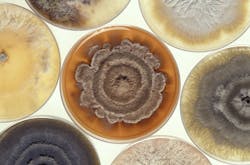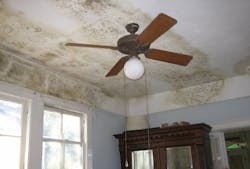Mold: A Growing Concern
From damp Delaware to dry Denver, home builders are struggling with rising risk related to mold.
In the Water Management Guide, by the Energy and Environmental Building Association, a key message is that controlling rain and ground-water entry are keys to controlling mold. The paper’s principal author is engineer Joe Lstiburek of Building Science Corp., in Westford, Mass. He and colleagues Terry Brennan and Nathan Yost also have authored a set of short papers about mold.
Four Reasons Why Mold Grows in Homes
Are TV crews and lawyers to blame for the concern about mold? Not really. We’ve always had journalists and lawyers. What has changed, Lstiburek says, is the moisture balance in our buildings, for the following four reasons:
1. Mold and Construction Methods
First, homes don’t dry out as quickly as they used to because we insulate better and build tighter. “Repeated wetting followed by repeated drying isn’t a problem,” says Lstiburek. “Today, buildings are still getting wet, as they always have, but they’re slower to dry.”
2. Mold and Materials
Second, homes today are built with more moisture-sensitive materials. Mold likes processed wood more than it likes lumber. “Paper is nature’s most perfect mold food,” says Lstiburek. “So where were the adults when it was decided that covering drywall with green paper would prevent bathroom mold problems?”
Covering drywall with green paper does nothing to prevent bathroom mold growth.
3. Mold and Design Flaws
Third, we’ve reduced a home’s “hygric buffer capacity,” its ability to soak up and store some moisture that enters the building shell because of design flaws or imperfect workmanship. Compared with decades past, homes have less masonry and more paper-faced drywall. Masonry absorbs more moisture than wood, wood more than drywall. Steel can’t absorb water.
4. Mold and Ventilation
Finally, we circulate a lot of air more frequently in modern buildings than in 30- to 50-year-old homes. And because most ductwork leaks, different parts of the home get pressurized or depressurized. When that happens, we can pull unwanted moisture from where we don’t want it (crawl spaces, attics, the humid outdoors) and deliver it where we don’t want it (vulnerable building elements such as rim joists and cathedral ceilings).
“These four practices have changed the dwell time of moisture in our buildings,” Lstiburek says. “So building elements that get wet stay wet longer. We need to alter our designs and workmanship to adjust for those realities.”
What Is Mold?
Mold is a fungus that’s virtually everywhere — in the air, under a pile of leaves, on a slice of bread. We’re exposed to mold every day.
Mold spores, the invisible “seeds” that can spread mold, need four conditions to grow: moisture or high relative humidity (70% to 80%); food (dirt, wood or organic material); oxygen; and temperatures from 40 to 100 degrees Fahrenheit.
“Wood starts decaying when it reaches over 28% moisture content by weight and continues decaying until it drops below 20%,” says Lstiburek. “So keep wood below the ‘off switch’ — 19% or less. Since mold will grow on wood at 16% moisture content, keep wood below that ‘off switch,’ too — 15% or less.”
Testing for Mold in the Home and How to Respond
If you smell mold, you probably have it, so look for the source. Brennan, of Camroden Associates in Rome, N.Y., says to look for wet spots in attics, crawl spaces, walls with plumbing or under windows.
“I generally don’t recommend air sampling for investigating mold problems in buildings,” Brennan says. “There’s a poor return on the money spent” because mold concentrations in the air vary dramatically with time. Air sampling costs $50 to $100 per sample, and consultants often take a half-dozen to a few dozen samples.
Brennan is researching the value of drilling and testing air samples from enclosed wall cavities that might hide mold. He covers one side with rigid plastic and the other with drywall, and then raises moisture levels within the cavities and matches visual observations with air samples obtained through small holes.
If you find mold, carefully assess the problem before any cleanup. Identify the moisture source that’s causing the problem and isolate it. Identify the extent of contamination and any safety precautions needed during remediation; follow the New York City Health Department’s Guidelines for Mold Remediation (see Additional Resources, below). Clean off the mold with soap and water or remove the damaged materials, realizing that re-moval releases more mold spores than simple cleaning. Dry out the assemblies. Replace any structurally damaged materials. For cosmetic purposes, paint over any stained exposed surfaces.
A risk threshold for mold exposure hasn’t been established. To muddy the water further, people have widely differing reactions to different levels and different types of mold.
Water infiltration in basements can be a major source of mold in homes. Controlling rain-water and ground-water entry are keys to controlling mold.
“If mold were as bad as some press reports, most of us would already be dead,” Lstiburek says. “We would have to ban farming and forestry, outlaw composting, and require respirators when you mow your lawn. That said, some molds cause problems, and toxic molds can cause serious problems. But today, the science is really quite thin, and we mostly have stories, anecdotal evidence.”
Yost, formerly a consultant with the Health House program of the American Lung Association and now with Building Science Corp., also seeks to “counter the hysteria that any mold is like plutonium. Exposure to a little mold is not a problem for most people.”
But Yost cites studies showing that the incidence of asthma in young children more than doubled during the past two decades. That trend is primarily an urban phenomenon of the industrialized world. Ethnicity, race and geography apparently aren’t key variables, so indoor air is increasingly viewed as a suspect.
“The mold-asthma connection is really the heart of the mold worries,” Yost says. “Mold can trigger asthma. What is not proven is whether exposure to mold can lead to the development of asthma. The more we study asthma and mold, the more we discover about how mold affects us. It is beginning to look as if some of these mold effects are not particularly nice.”
Additional Mold Resources
Centers for Disease Control: Information on the health effects of mold
Environmental Protection Agency: Mold resources
EEBA: Building practices to prevent moisture problems
National Association of Home Builders: A wide range of information for members and nonmembers
New York City Department of Health: Guidelines on the assessment and remediation of fungi in indoor environments
Restoration Consultants: A variety of background on mold remediation and mold dangers
The Energy and Environmental Building Association is a membership-based, not-for-profit organization dedicated to providing awareness, education and development of better building principles and practices. EEBA’s educational outreach includes the EEBA Institute, providing training and Web-based programs, and the annual Excellence in Building Conference. For information on EEBA, visit its website or call 952.881.1098.

